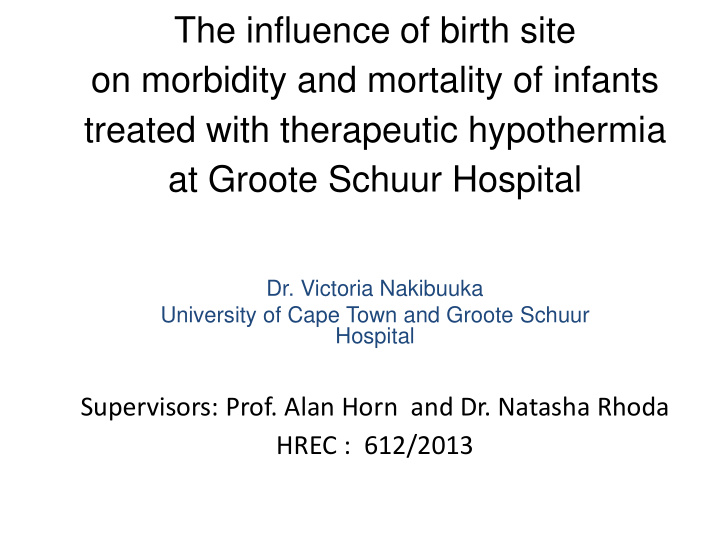



The influence of birth site on morbidity and mortality of infants treated with therapeutic hypothermia at Groote Schuur Hospital Dr. Victoria Nakibuuka University of Cape Town and Groote Schuur Hospital Supervisors: Prof. Alan Horn and Dr. Natasha Rhoda HREC : 612/2013
Background • HIE is a significant cause of death and developmental delay • Mortality 10 – 60 % • At least 25 % of survivors have adverse long-term outcome • HIE is 10 – 20 times more common in the developing world
Background • Cooling reduces mortality by 25% and disability by 32% • Hypothermia should be initiated within 6 hours of birth • Many babies are born outside the treatment centers • The extent to which outcome is compromised, by being born outside a treatment centre, has not been studied in South Africa
Objectives 1. To compare the frequency of mortality or abnormal aEEG at 48 hours in inborn vs. outborn infants with HIE who were treated with hypothermia. 2. To describe and compare the morbidity during admission in these two groups of infants.
Methods • Retrospective, comparative and descriptive analysis • Prospective registry of babies with mod-severe HIE and treated with hypothermia at GSH NICU • 1 January 2011 and 31 December 2012
Inclusion Criteria ≥ 36 wks and ≥ 1 800 g; mod-severe HIE; cooling started < 6 hours A. B. Evidence suggestive of potential intrapartum asphyxia 10-minute Apgar score < 7, or Ongoing respiratory support at 10 minutes, or Cord pH ≤ 7 or BD of ≥ 12 within 60 minutes of birth C. Signs of encephalopathy and aEEG voltage suppression or seizures 3 Signs of mod- Severe HIE defined by shankaran or, Depressed LOC plus abnormal tone or, HIE plus moderately abnormal/suppressed aEEG background
Exclusion Criteria Major congenital anomaly or congenital infection PPHN / systemic hypotension / bleeding that is not responding to treatment Moribund
Results 57 Infants with mod-severe HIE 23 (40%) In-born 34 (60%) Out-born
Baseline characteristics In-born Out-born P n = 23 n = 34 Male (%) 11 (47.8) 13 (38.2) 0.4 Mean Base Excess (SD) -16.6 (8) -16.6 (6) 0.9 Chest Compressions (%) 4 (17.3) 8 (23.5) 0.5 Preexisting Maternal Conditions (%) 12 (52.7) 9 (27.2) 0.05 Pregnancy Complications (%) 16 (60.8) 6 (18.1) 0.001 Non reassuring CTG (%) 11 (47.8) 7 (20.5) 0.03 Breech (%) 4 (17) 1 (3) 0.05 Cesarean section (%) 15 (65) 8 (24) 0.001 Instrumental (%) 0 4 (11) 0.08 SVD cephalic (%) 4 (17) 21 (61) 0.009 6-h CFM abnormal (%) 9/21 (42) 17/34 (50) 0.6 Median age at initiation of cooling (IQR) 2 (1-4) 4 ( 4-5) 0.0001
Pregnancy Complications 6 5 In born Number of patients Out born 4 3 2 1 0
Morbidity In born Out born P n = 23 n = 34 Hypoglycemia (%) 6 (27) 3 (9) 0.07 Hypomagnesaemia (%) 3 (13) 11 (32) 0.09 Hypotension (%) 3 (13) 6 (17) 0.6 Creatinine >115 (%) 1 (4) 2 (3) 0.7 Pulmonary Hypertension (%) 2 (9) 3 (9) 0.9 Meconium Aspiration (%) 3 (13) 4 (12) 0.9 Mechanical Ventilation (%) 7 (30) 13 (38) 0.5 Late onset Sepsis (%) 1 (4) 1 (3) 0.7 Sinus Bradycardia (%) 3 (13) 3 (9) 0.6
Out come at Discharge In- born Out - born 13 (38%) 10(32%) 5 (22%) 5(22%) No Nutritive Suck Mortality or abnormal CFM at 48 Hrs ( OR 1.5, 0.4 – 7.5) ( OR 2.23, 0.6 - 9.5)
Summary • 60% of infants treated with hypothermia were outborn • Pre-existing maternal conditions, pregnancy complications, non-reassuring CTGs and complicated deliveries occurred in a lower proportion of outborn vs. inborn infants • Cooling was initiated significantly later in outborn vs. inborn infants • Death or abnormal aEEG at 48 hours or absent nutritive suck at discharge occurred more often in outborn infants • Not significant - speculate due to small sample
Conclusions • Outborn infants with HIE comprise a significant proportion of the burden of disease in this centre • There are significant delays initiating cooling in outborn infants • The delay in cooling is a potentially avoidable factor associated with poor outcomes in the outborn infants • The apparent paucity of pregnancy and CTG abnormalities in referred infants may suggest opportunities for improved pregnancy and intrapartum monitoring • These findings should be explored in a larger study to adequately inform policy
• THANK YOU FOR LISTENING
Outcome at 48 hours In Born Out Born (OR 1.5, 0.5 -7) 10 (31%) (OR 1.81, 0.3 -20) 5 (15%) 5 (22%) 2 (9%) Mortality CFM abnormal at 48 hrs
Recommend
More recommend